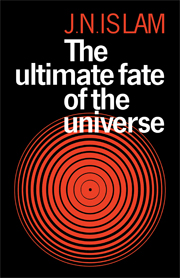Book contents
- Frontmatter
- Contents
- Preface
- Dedication
- Note on some conventions
- 1 Introduction
- 2 Our Galaxy
- 3 The large-scale structure of the universe
- 4 Elementary particles – a preliminary look
- 5 Is the universe open or closed?
- 6 Three ways for a star to die
- 7 Black holes and quasars
- 8 Galactic and supergalactic black holes
- 9 A black hole is not forever
- 10 Slow and subtle changes
- 11 Future of life and civilization
- 12 A collapsing universe
- 13 The steady state theory
- 14 The stability of the proton
- 15 Epilogue
- Glossary
- Selected bibliography
- Index
6 - Three ways for a star to die
Published online by Cambridge University Press: 06 July 2010
- Frontmatter
- Contents
- Preface
- Dedication
- Note on some conventions
- 1 Introduction
- 2 Our Galaxy
- 3 The large-scale structure of the universe
- 4 Elementary particles – a preliminary look
- 5 Is the universe open or closed?
- 6 Three ways for a star to die
- 7 Black holes and quasars
- 8 Galactic and supergalactic black holes
- 9 A black hole is not forever
- 10 Slow and subtle changes
- 11 Future of life and civilization
- 12 A collapsing universe
- 13 The steady state theory
- 14 The stability of the proton
- 15 Epilogue
- Glossary
- Selected bibliography
- Index
Summary
In this chapter we shall discuss briefly how stars are born and how they evolve during their life, and then we shall consider in some detail how they eventually die, that is, reach the three final states of white dwarf, neutron star and black hole. We shall also discuss the phenomenon of supernova, a phenomenon which is relevant to the final state of some stars.
The precise manner in which stars are formed is not clearly understood. The region between the stars is not empty but consists of gas clouds, consisting mostly of hydrogen, and dust grains of various kinds. The material between the stars is not uniformly distributed in space but is spread in a patchy fashion. In most places the density of gas is very low, a typical density being 10−19 kg/m3, that is about a hundred million (108) hydrogen atoms per cubic meter. Now the gravitational force between two portions of matter is inversely proportional to the square of the distance between them (for example, if the distance is doubled, the force becomes a quarter) and directly proportional to the product of the masses (if the masses of both portions are doubled, the force becomes four times as strong). Thus in a gas cloud, the higher the density of the gas, the stronger the gravitational attraction of different parts for each other.
Occasionally a cloud will become sufficiently dense and massive for gravitational attraction to draw it close together (this could conceivably happen also in the neighbourhood of a supernova explosion, as will be explained later).
- Type
- Chapter
- Information
- The Ultimate Fate of the Universe , pp. 57 - 72Publisher: Cambridge University PressPrint publication year: 1983



